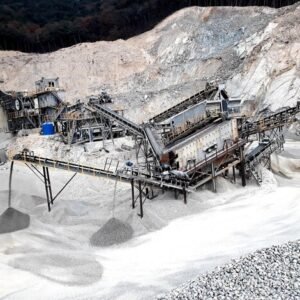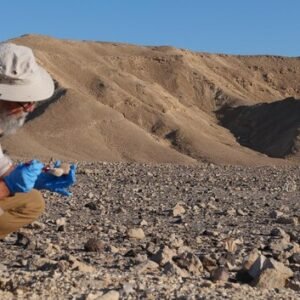A Geosynthetic Clay Liner (GCL) is an engineered material used as a barrier in construction and environmental protection projects to control the movement of fluids and gases. It consists of a layer of natural sodium bentonite clay sandwiched between two layers of geotextile or bonded with geomembranes. GCLs are renowned for their ability to create an effective hydraulic barrier, largely due to the sodium bentonite clay, which expands significantly when exposed to water, filling gaps and creating a low-permeability seal.
GCLs offer unique properties:
- Self-sealing capabilities, as the bentonite swells to close minor punctures.
- Flexibility and adaptability, as they can conform to uneven surfaces.
- Ease of installation, which can lead to cost savings over traditional clay liners.
These characteristics make GCLs an effective solution for a wide range of applications in civil engineering, environmental protection, and resource management.
Composition and Structure of GCLs
The main component of a GCL is sodium bentonite clay, a naturally occurring material that has a high capacity to absorb water and swell. This swelling ability is essential to creating a tight seal against fluid movement. Sodium bentonite is typically enclosed between two layers of geotextiles (woven or non-woven fabric) that are needle-punched or stitched to enhance structural stability.
- Geotextile Layers: These layers are usually composed of polypropylene or polyester and provide strength and durability to the GCL. The outer layers also protect the bentonite clay from erosion and damage.
- Bentonite Clay Core: The core clay expands upon hydration, reducing permeability and creating a seal against liquid and gas intrusion.
Some GCLs have an added geomembrane layer, which enhances impermeability and is beneficial in applications with harsh chemical exposure.
Types of Geosynthetic Clay Liners
GCLs are classified based on their construction and the specific project requirements. The main types include:
- Non-reinforced GCLs: These consist of bentonite clay and a simple geotextile cover. They are less durable than reinforced GCLs but are cost-effective for lighter applications.
- Reinforced GCLs: These incorporate a needle-punched or stitch-bonded reinforcement, adding strength and ensuring stability against shear forces. Reinforced GCLs are ideal for applications where stability is critical, such as in landfill containment.
- Composite GCLs: These are reinforced GCLs that also include a geomembrane layer, enhancing their impermeability and durability in chemically harsh environments, such as industrial waste containment.
Uses and Applications of Geosynthetic Clay Liners
Due to their versatility and environmental benefits, GCLs are used in various civil and environmental engineering applications, including:
1. Landfill Liners and Covers
- Base Liners: GCLs form a barrier at the bottom of landfills, preventing leachate (a toxic liquid produced by waste breakdown) from seeping into the surrounding soil and groundwater.
- Capping Systems: For closed or capped landfills, GCLs can act as a cover to minimize rainwater infiltration, reducing leachate production and promoting safer waste storage.
2. Pond and Canal Linings
- Water Reservoirs: GCLs are often used to line reservoirs, retention ponds, and dams, reducing water seepage into the ground.
- Canal Linings: In irrigation canals, GCLs prevent water loss, improving the efficiency of water delivery systems, especially in arid regions.
3. Mining Applications
- Heap Leach Pads: In mining operations, GCLs serve as a barrier under heap leach pads, containing the leachate from ore piles and preventing it from contaminating the soil.
- Tailings Storage: GCLs can be used to line tailings storage facilities, preventing toxic materials from leaching into the environment.
4. Containment of Hazardous Waste
- Industrial Waste Containment: GCLs are used to line storage areas for hazardous chemicals, preventing potential contamination of the surrounding environment.
- Radioactive Waste Containment: For facilities storing low-level radioactive waste, GCLs provide an effective barrier, containing any potential seepage from radioactive materials.
5. Roadway and Rail Track Beds
- In certain geotechnical engineering projects, GCLs are used beneath roadways and railways, particularly in areas prone to soil moisture variations. The liners help maintain the stability of these structures by preventing water from reaching and weakening the subgrade.
6. Environmental and Water Protection
- Wetland and Habitat Restoration: GCLs are employed to retain water in wetland restoration projects, creating artificial basins or ponds that support ecosystems.
- Groundwater Protection: In areas with high water tables, GCLs are used to prevent the contamination of groundwater from industrial, agricultural, and urban runoff.
Advantages of Geosynthetic Clay Liners
GCLs are a popular choice for containment due to several advantages over traditional compacted clay liners:
1. Cost-Effectiveness
- GCLs are easier to transport and install, which reduces labor and equipment costs. They also require less space than compacted clay liners (CCLs), which are typically thicker.
2. Improved Performance
- The high swelling capacity of bentonite clay ensures a low hydraulic conductivity, even in areas with punctures or minor irregularities. This provides a highly effective seal, outperforming traditional clay liners.
3. Environmental Friendliness
- Bentonite clay is a natural and non-toxic material, and GCLs help prevent soil and groundwater contamination. Their thin profile also reduces the amount of material required, lowering the environmental footprint of construction.
4. Durability and Versatility
- GCLs can withstand freeze-thaw cycles, wet-dry conditions, and changes in soil pressure, making them suitable for various climates and environments.
5. Flexibility in Installation
- GCLs can be installed on slopes and uneven ground without significant performance loss. They are ideal for complex shapes, reducing the number of seams required.
Installation Process of Geosynthetic Clay Liners
The installation process of GCLs involves several critical steps to ensure optimal performance and longevity:
- Site Preparation: The surface should be smooth, firm, and free of sharp objects that could damage the GCL.
- GCL Placement: GCL panels are rolled out, usually with an overlap of at least 6 inches, and seam edges are carefully placed to ensure continuous coverage.
- Hydration: In some cases, GCLs are hydrated after installation to allow the bentonite clay to swell, enhancing the seal. Natural hydration from rainfall may also suffice.
- Quality Control: Inspections are conducted to ensure the GCL is undamaged and installed correctly.
Limitations and Considerations
While GCLs offer numerous benefits, there are certain limitations and considerations:
- Sensitivity to Chemical Contamination: In environments with high salinity or certain chemicals, bentonite may lose its swelling ability, impacting performance.
- Strength Limitations: GCLs might not withstand high shear forces on steep slopes without additional reinforcement, so they may require stabilization measures.
- Hydration Requirements: For GCLs to achieve optimal performance, proper hydration is essential. In arid regions, this may require additional steps during installation.
- Potential for Punctures: Although GCLs have self-sealing properties, large punctures or tears may compromise their integrity, requiring careful handling and inspection.
Conclusion
Geosynthetic Clay Liners are an invaluable tool for modern civil engineering, providing a reliable, cost-effective, and environmentally friendly solution to fluid and gas containment challenges. Their unique composition, leveraging the swelling properties of bentonite clay, enables GCLs to deliver a highly effective seal across a variety of applications. From waste containment and water management to environmental restoration, GCLs are versatile and durable, offering benefits that traditional clay liners cannot match. The demand for sustainable and effective containment solutions is growing, and GCLs are likely to play a crucial role in meeting these needs across diverse industries.







